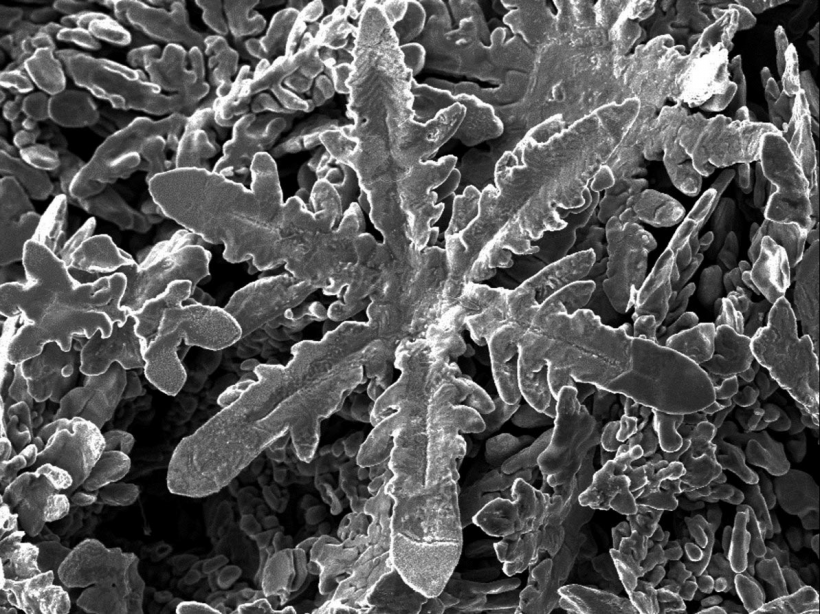Scientists in New Zealand and Australia have been able to manipulate metals at the atomic level, leading to the creation of small metallic snowflakes. This is a significant achievement because it demonstrates the ability to get individual atoms to work together, which has the potential to revolutionize engineering and technology through the use of nanomaterials.
Nanoscale structures, which are extremely small (about 50,000 times smaller than the diameter of a human hair), have various potential applications including improving electronic manufacturing, enhancing the strength and lightness of materials, and helping with environmental clean-ups by binding to toxins.
Metallic Snowflakes From a Variety of Metals
New Zealand and Australian scientists have been experimenting with gallium, a metal commonly used in semiconductors, to create metallic nanocrystals. The scientists conducted their experiments using gallium, which is a soft, silvery metal that becomes liquid at slightly above room temperature. The results of their experiments were published in the journal Science on December 8.
Professor Nicola Gaston and research fellow Dr. Steph Lambie, both from the University of Auckland, and Dr. Krista Steenbergen from Victoria University of Wellington in New Zealand worked with Professor Kourosh Kalantar-Zadeh and his team at the University of New South Wales in Australia to create metallic nanocrystals. The researchers used a variety of metals including nickel, copper, zinc, tin, platinum, bismuth, silver, and aluminum, which were dissolved in gallium at high temperatures. After cooling, the metallic crystals formed while the gallium remained liquid.
The New Zealand team, which is affiliated with the MacDiarmid Institute for Advanced Materials and Nanotechnology, a national center of research excellence, used simulations of molecular dynamics to understand why differently shaped crystals form from different metals. According to Professor Gaston, their research has shown that the structure of the liquid gallium is very important, which is unusual because liquids are typically thought of as lacking structure or being randomly structured. The team's research was supported by the Marsden Fund, a government-supported program.

Nano-scale snowflake from Gallium solvent.
ALSO READ: Unique Approach in the Battle Against Malaria Uses Nanoparticles That Attack the Parasite
Snowflake Zinc Crystals
According to scientists, the differently shaped crystals that emerge are a result of interactions between the atomistic structures of the different metals and the liquid gallium. These crystals include cubes, rods, hexagonal plates, and zinc snowflakes. The snowflake design of the zinc crystals is due to their six-branched symmetry, with each atom surrounded by six neighbors at equivalent distances.
Following the SciTechDaily report, this research uses a bottom-up approach to creating nanostructures, which involves atoms self-assembling rather than cutting away material as in top-down approaches. This method, which is how nature creates nanoparticles, is more precise and less wasteful than top-down approaches. Professor Gaston states that this research has opened up a new, unexplored pathway for creating metallic nanostructures and adds that there is something very cool about creating a metallic snowflake.
Metals can be dissolved in liquid gallium at high temperatures and will then precipitate out of the solution when cooled. However, it is difficult to extract these crystals due to the high surface tension of the liquid metal. Idrus-Saidi developed a method for extracting these crystals by applying a voltage to the liquid metal solution while using vacuum filtration. This process produces crystals with intricate morphologies, some of which resemble snowflakes. It is believed that this method can be used to create a variety of morphologies for metal particles made from a wide range of elements and alloys.
RELATED ARTICLE: People Can Now Make Metal Snowflakes With Zinc's Help!
Check out more news and information on Nanoparticles in Science Times.


![Earth's Quasi-Moon Kamo‘oalewa Could Originate From Lunar Surface Not Asteroid Belt [Study]](https://1721181113.rsc.cdn77.org/data/thumbs/full/53275/89/56/50/40/earths-quasi-moon-kamo-oalewa-could-originate-from-lunar-surface-not-asteroid-belt-study.png)











